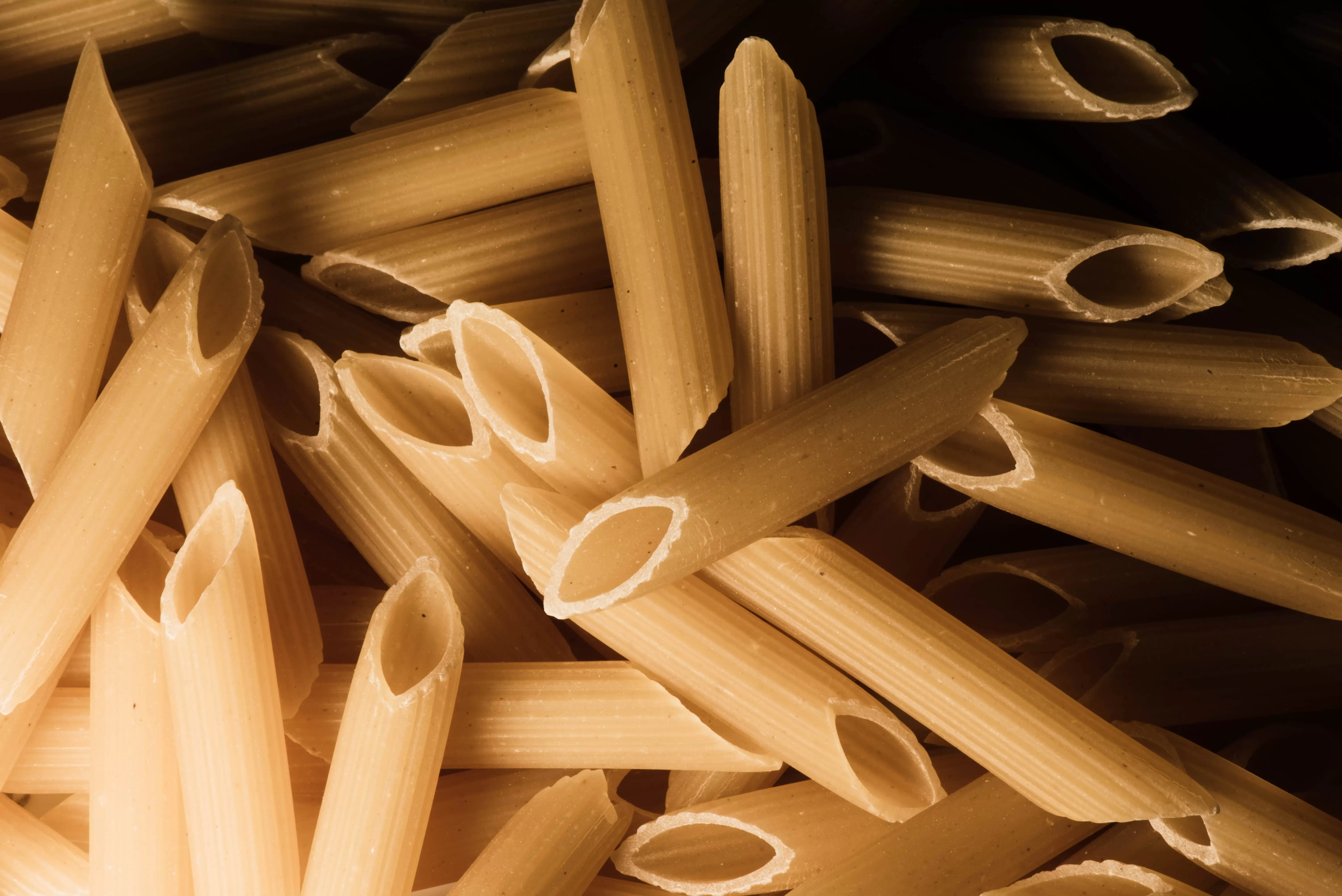Detailed content of our market study
 Inforamtion
Inforamtion
- Number of pages : 35 pages
- Format : Digital and PDF versions
- Last update :
 Summary and extracts
Summary and extracts
1 Market Overview
1.1 Definition and presentation
Pasta is a food made from hard or soft wheat flour, often mixed with water and sometimes eggs, shaped into various shapes and sizes, dried or prepared fresh, and typically cooked in boiling water. it is a mainstay of Italian cuisine, used in a wide variety of dishes and seasoned with different sauces and ingredients.
The global pasta market will grow from US$71.42 billion in 2024 to US$100.24 billion by 2032, with a compound annual growth rate (CAGR) of 5.47 percent during the 2025-2032 forecast period. In 2023, Italy clearly stands out in per capita pasta consumption with 23 kg, almost double that of the second country, Tunisia, with 17 kg. It is followed by Venezuela with 15 kg and Greece with 12.2 kg. Our country is confirmed as the world's largest producer of pasta with 3,670,000 tons, clearly distancing other countries. The United States and Turkey follow with similar production, 2,000 and 1,987 thousand tons respectively.
From 2023 to 2029, the value of the European pasta market is expected to grow steadily from USD 20.19 billion to USD 31.25 billion. This represents a 54.8 percent increase in six years at a compound annual growth rate of 7.55 percent. The European market accounts for 29.54 percent of the global total.
In recent yearsthe turnover of Italian pasta production companies has grown by 32.5 percent, as has the value of production sold, which has increased by 56.5 percent. Good news also regarding production made and sold, which increased by 21.9% and 24% respectively, these figuresreflect strong demand for pasta and robust growth in the Italian pasta market in terms of value.
1.2 The global market
The global pasta market was valued at US$**.** billion in **** and is expected to grow from US$**.** billion in **** to US$***.** billion by ****, with a compound annual growth rate (***) of *.** percent during the forecast period ****-****.
Global pasta market value World, ****-****, in US$ billion FortuneBusinessInsights
In ****, Italy stands out clearly in terms of per capita consumption of pasta with ** kg, almost double that of the second country, Tunisia, with ** kg. It is followed by Venezuela with ** kg and Greece with **.* kg. The other countries, including Peru, Chile, the US, Turkey, Iran, France and Germany, show consumption between *.* kg and *.* kg, showing a significant difference from Italy.
World per capita consumption of pasta World, ****, in kg ItalianFood
In ****, Italy is confirmed as the world's largest pasta producer with *,*** thousand tons, clearly distancing other countries. The United States and Turkey follow with similar production, *,*** and *,*** thousand tons respectively. Egypt and Brazil are at similar levels, with *,*** and *,*** thousand tons. Russia produces *,*** thousand tons, while Nigeria, with *** thousand tons, leads African producers. Iran, Peru and Tunisia, with productions of ***, *** and *** thousand tons respectively, close the top ten producers. Major world producers of pasta World, ****, in thousand tons UN.A.F.P.A.
In ...
1.3 The European market
From **** to ****, the value of the European pasta market is expected to grow steadily from USD **.** billion to USD **.** billion. This represents a **.* percent increase in six years at a compound annual growth rate of *.** percent. The positive trend underscores the importance of pasta in the European food market and its growing popularity among consumers. European pasta market value Europe, ****-****, in US$ billion FortuneBusinessInsights, MondorIntelligence
In ****, Europe's pasta market share accounts for **.** percent of the global total, while the rest of the world covers **.** percent. This figure shows that although Europe is a relevant market, most of the quotations are located outside the continent, indicating strong international demand and competitiveness in the pasta sector. The global presence of market quotations underscores the global spread and importance of pasta. Pasta market quotations Europe, ****, in % FortuneBusinessInsights
Between **** and ****, pasta production in the European Union increased by **.* percent, from **** to **** thousand tons. This increase is characterized by fluctuations, with a peak in **** at **** thousand tons, followed by a decrease in the following years. On the other hand, consumption decreased slightly by *.*%, from **** to **** thousand tons. Again, fluctuations are observed, with a high in **** at **** thousand tons and a significant drop in **** at **** thousand ...
1.4 The Italian market
The turnover of companies producing pasta, couscous and similar flour products grew by **.* percent between **** and ****, from *.** billion to **.** billion. After growing steadily until ****, the increase accelerated in ****, probably due to rising raw material prices. For ****, the estimate shows a slight contraction to **.** billion, suggesting a possible stabilization of the market after the strong expansion in recent years. The **** and **** values were estimated using the relevant istat index on industry turnover.
Turnover of companies producing pasta, couscous and similar farinaceous products [***] Italy, ****-****, in billion € Istat, Companies Register
Between **** and ****, the value of pasta production sold in Italy increased by **.* percent, from €*.** billion to €*.** billion. After a decline in ****, a steady recovery is observed with a particularly significant increase between **** and ****. This increase reflects strong demand for pasta and robust growth of the Italian pasta market in value terms.
Value of pasta production sold Italy, ****-****, in billion € Istat
The categories present in pasta production sold are as follows, and they have these percentages within the merate:
[***] Uncooked and unstuffed pasta containing eggs [***] Other uncooked nor stuffed pasta (***)
Breakdown of various types of pasta in production sold by value Italy, ****, in % Istat
1.5 Imports and Exports
The Italian pasta market is recognized worldwide for the excellence of its products. In fact, as the chart below shows, the value of exports is far higher than imports. Every year, on average, exports are ****% higher than imports, and it is irrelevant to compare them.
From **** to ****, Italy's pasta exports have shown steady and significant growth. Starting from a value of $*.** billion in ****, there was an **.*% increase in ****, reaching $*.** billion. In ****, the value rose marginally to *.** billion, showing a more modest increase. However, in ****, exports surged significantly by **.* percent to *.** billion. This positive trend continued in ****, with a further increase of *.* percent, bringing the value of exports to *.** billion. Overall, Italy's pasta exports grew by ** percent during the period analyzed, highlighting the robustness and growing demand for the Italian product in international markets.
Value of pasta exports Italy, ****-****, in US$ billion UNComtrade
As previously mentioned, imports of the pasta product and its primary derivatives, are not comparable to exports of the same product. From **** to ****, pasta imports to Italy showed some variability. In ****, the value of imports was **.* thousand, which increased by *.* percent in **** to ***.* thousand. However, in ****, there was a slight decrease to $***.* thousand. In ****, imports rose again to ...
1.6 Inflation suffered by the sector
The pasta sector in Italy has faced significant challenges due to inflation. Increases in the cost of raw materials, such as durum wheat, and energy costs have led to higher production prices. This increase in costs has inevitably been reflected in consumer prices, making pasta more expensive for consumers. Faced with this situation, pasta producers have adopted various strategies to mitigate the impact of inflation. Some have tried to optimize production and reduce waste to keep costs down, while others have increased their premium product offerings, trying to attract consumers willing to pay more for higher quality. In addition, there has been an increased focus on diversifying supply markets to avoid critical dependencies on single suppliers. Inflation has also spurred an increase in cheaper pasta imports from other countries, but Italian producers have leveraged the strong "Made in Italy" brand and perceived quality of Italian pasta to maintain their market share.
Producer price index for pasta, couscous and similar flour products from the industry - monthly data - base ****=*** Italy, ****-****, index Istat
The producer price index of pasta, couscous and similar farinaceous products in Italy showed an upward trend between May **** and January ****, rising from ***.* to ***.*. Thereafter, the index began ...
2 Demand analysis
2.1 Overview of demand
Monthly household spending on pasta increased by **.* percent between **** and ****, from **.** euros to **.** euros. After a growth in ****, probably related to the increase in household consumption during the pandemic, there was a slight decline in the next two years, followed by a sharp increase in ****. This recent uptick is consistent with the increase in industry sales and could reflect both inflation and a higher unit value of the product purchased.
Household monthly expenditure item for pasta Italy, ****-****, in current &euro Istat
Pasta production in Italy between **** and **** showed significant fluctuations. In ****, production was *,*** thousand tons, falling significantly to *,*** thousand in ****. In ****, production rebounded to *,*** thousand tons and peaked at *,*** thousand in ****, likely due to higher demand related to the pandemic. In ****, there was a dramatic increase to *,*** thousand tons, followed by a slight decrease in ****, with *,*** thousand tons. Overall, from **** to ****, pasta production increased by **.* percent, with a particularly significant increase in ****-****. Production realized in quantity of pasta Italy, ****-****, in thousands of tons Istat
Sold production of pasta in Italy between **** and **** showed a similar trend to overall production. In ****, the quantity sold was *,*** thousand tons, dropping to *,*** thousand in ****. In ****, it rose again to *,*** thousand tons, and ...
2.2 Geographical distribution of demand
In ****, the geographical distribution of average monthly household spending on pasta in Italy shows regional differences. Central households incurred the highest expenditure, at **.** euros per month. The Northeast and Northwest spent a similar amount, at **.** euros. In the South and Islands, the average expenditure was lower, standing at **.** euros. These data show geographic variation in pasta spending habits, with the central and northern regions tending to spend more than the South and Islands.
body { font-family: Arial, sans-serif; margin: **px; } table { width: **%; border-collapse: collapse; margin: **px *; } th, td { border: *px solid #dddddd; text-align: left; padding: *px; } th { background-color: #f*f*f*; }
Pasta production begins with the cultivation of winter wheat, a hardy grain that is sown during the fall to take advantage of winter rains and mature best with the arrival of spring. This grain, characterized by high protein and gluten content, is the main ingredient in pasta production. In ****, total winter wheat and spelt production in Italy, measured in quintals, shows significant regional variability. Emilia-Romagna was the leading region with a production of *,***,*** quintals, followed by Veneto with *,***,*** quintals and Lombardy with *,***,*** quintals. Piedmont recorded a production of *,***,*** quintals, while Friuli-Venezia Giulia produced ***,*** quintals. Central regions such as Tuscany and Umbria ...
2.3 Demand drivers
The Italian pasta market, as this is a traditional and culturally representative product of the "bel paese," has specific characteristics at the level of demand. Pasta is one of the basic elements of Italian cuisine and present in all cuisines, which is why the demand for pasta varies significantly in accordance with the variation of the Italian population.
As anticipated in the previous section, the global market for Italian pasta is continuously increasing and consequently, the demand for pasta does not see negative influences other than a general increase in prices related to the increase in raw material prices[***].
Recently, pasta consumption in Italy has turned to the product derived from *** percent Italian wheat, registering an increase of ** percent, triple the trend in demand for pasta from non-fully Italian raw materials. The trend can certainly be attributed to the Covid pandemic, which has influenced and changed the consumption habits of Italians, bringing the population back to a greater choice of the Mediterranean diet, as also shown by the '** percent average increase in consumption in **** of the basic products of that diet, such as extra virgin olive oil, bread, fruits and vegetables and pasta. The lockdown-induced return to raw materials and ...
2.4 Trend in demand for pasta
The trend of online searches for pasta in Italy between **** and **** shows variability with some notable peaks. In July ****, the index was **.* and saw a slight increase in August to **.*. Between September and November ****, the index increased, peaking at **.* in November, and continued to rise to **.* in December ****. In January ****, the index decreased slightly to **.* and fluctuated until June ****, with values between **.* and **.*. In August ****, the index experienced another significant increase to **.*, followed by a fluctuation with a peak of **.* in December ****. Since January ****, the index has shown a downward trend, falling to **.* in June **** and rising slightly to **.* in July ****. Overall, online interest in pasta showed a significant increase in the second half of **** and ****, followed by a downward trend in ****, with a change of -*.* percent between July **** and July ****.
The numbers represent search interest relative to the highest point on the graph in relation to the region and period indicated. A value of *** indicates the highest search frequency of the term, ** indicates half of the searches. A score of *, on the other hand, indicates that not enough data were found for the term.
Trend of online searches for pasta Italy, ****-****, index Google Trends, Businesscoot elaboration
Between **** and ...
2.5 New trends in demand
In recent years, the pasta market has experienced significant evolution, driven by a combination of factors related to new eating habits, environmental concerns, and technological innovations. Consumer preferences are changing, with a growing demand for healthier, more sustainable and convenient products. This dynamic landscape has led to the emergence of new trends that are shaping demand for pasta globally. Below, we explore these new trends and their implications for the market in detail.
*. alternative Ingredient Pasta: Growing awareness about food intolerances and special diets has led to increased demand for pasta made with alternative ingredients:
Gluten-Free Pasta: Made with rice, corn, quinoa, and buckwheat flour. it is especially popular among consumers with celiac disease or gluten sensitivity. Pulsed Pasta: Use of lentils, chickpeas, peas, and beans to increase protein and fiber content, meeting the needs of high-protein, low-glycemic-index diets. Vegetable Pasta: Supplemented with vegetables such as spinach, beets, and carrots, ideal for those seeking to increase vegetable intake in their diet.
*. Artisan and High Quality Pasta: There is a return toward more traditional, artisanal products:
Artisan Pasta: Made using traditional methods, often by small local businesses using ancient grains such as spelt, kamut and emmer. Durum Wheat Semolina Pasta: ...
3 Market structure
3.1 Market structure and dynamics
Between **** and ****, the number of enterprises active in the production of pasta, couscous and similar farinaceous products in Italy declined by * percent, from *,*** to *,***. After a slight increase in ****, the number declined steadily until ****, and then rose again slightly in ****. This trend suggests a slight decline in the sector, with an overall reduction of ** enterprises in five years.
Number of enterprises active in the production of pasta, couscous and similar farinaceous products [***] Italy, ****-****, in number Istat
In ****, the majority of enterprises active in the production of pasta, couscous and similar farinaceous products in Italy were sole proprietors, freelancers and the self-employed, accounting for **.** percent of the total. Limited liability companies made up **.** percent, while general partnerships and limited partnerships accounted for **.** percent and *.** percent, respectively. Joint stock companies and limited partnerships accounted for only *.** percent, and other business forms accounted for *.** percent. These figures indicate a predominance of simpler, individual legal forms over more complex corporate structures. Legal form of enterprises active in the production of pasta, couscous and similar farinaceous products Italy, ****, in % Istat
Between **** and ****, the number of people employed in the production of pasta, couscous and similar farinaceous products in Italy increased by *.* percent, from **,*** to **,***. The ...
3.2 Value chain
The value chain and operation of the pasta market in Italy are summarized below.
Source: ****
3.3 Distribution channels
Pasta distribution channels in Italy are multiple and well-structured, reflecting the importance of this product in the country's culture and economy. It is characterized by a complex and well-articulated network that ranges from artisanal production to large-scale organized distribution, passing through a series of intermediate and direct channels that guarantee widespread coverage of the national and international territory. This network ensures that pasta, a fundamental element of the Italian diet, is always available and accessible to all consumers, both in Italy and abroad. Below is a detailed description of the main distribution channels for pasta in Italy:
*. Direct Production and Distribution: Pasta companies, from large brands to small artisanal pasta makers, can sell directly to consumers through various channels:
Company Outlets: Many manufacturers have outlets at their locations where consumers can purchase products directly. These outlets often offer competitive prices and the ability to purchase fresh products in large quantities. Online Sales: Many pasta manufacturers have developed e-commerce platforms to sell directly to consumers. This channel is growing because of the convenience and ability to reach customers throughout Italy and abroad.
*. Wholesalers and Distributors: They play a crucial role in pasta distribution, buying large quantities of product from producers ...
3.4 The main players in the market
The main Italian pasta companies are as follows:
Barilla: Founded in **** in Parma, it is one of the largest and most recognized food companies in the world. it is the world leader in pasta production, with a **.* percent market share in Italy, and offers more than *** different types of pasta. It also produces a wide range of bakery products, sold under such well-known brands as Mulino Bianco, Pan di Stelle, and Wasa, which is the world's largest producer of crispbread. The company operates in more than *** countries and has ** production plants. In ****, Barilla reported sales of *.*** billion euros and a net profit of *** million euros. The company's mission is to promote "the joy of food for a better life," focusing on quality and sustainability (***).
Fratelli De Cecco: Established in **** by Filippo De Cecco in Fara San Martino, Abruzzo. The company is known for the superior quality of its products, achieved through traditional methods and technical innovations. It is the third largest pasta producer in the world, with significant growth in demand for its products, registering a ** percent increase in ****. Its product range includes durum wheat semolina pasta, egg pasta, whole wheat pasta, gluten-free pasta, and extra virgin olive oil. It uses ...
4 Supply analysis
4.1 Type of the offer
The types of pasta offerings in Italy are extremely varied and reflect both tradition and innovation in the food industry. Below is a detailed description of the main categories and types of pasta offerings:
Nutritional reference values for pasta, taking *** g of dry durum wheat pasta as a sample, provide about *** calories, divided into carbohydrates, protein and fat as follows in the pie chart below:
Nutrition label for *** g of Dry Pasta Composition nutritional values, in % Source: ****
table { width: ***%; border-collapse: collapse; } th, td { border: *px solid #ddd; padding: *px; } th { background-color: #f*f*f*; } tr:hover { background-color: #f*f*f*; }
table { width: ***%; border-collapse: collapse; } th, td { border: *px solid #ddd; padding: *px; } th { background-color: #f*f*f*; } tr:hover { background-color: #f*f*f*; }
4.2 The price analysis
The Whole Community Consumer Price Index for dry pasta, fresh pasta and couscous in Italy shows an upward trend from June **** to June ****. In June ****, the index was ***.*, while in June **** it increased to ***.*. This represents an increase of * percent. The index peaked at ***.* in March ****, and then began to decline gradually. In the period between June **** and June ****, there were significant fluctuations, with a steady increase until March ****, followed by a decrease and stabilization in the following months.
Consumer price index for whole collectivity of dry pasta, fresh pasta and couscous [***] (***) - monthly data Italy, ****-****, index Istat
The Consumer Price Index for the Whole Community of Dry Pasta, Fresh Pasta and Couscous in Italy showed a significant increase from **** to ****. Starting from an index of **.* in ****, the index reached ***.* in ****, marking a ** percent increase. From **** to ****, the increase was relatively modest and gradual, with values ranging from **.* to ***.*. However, from **** to **** there was a significant increase of **.* percent, followed by a further increase of *.* percent in ****. Consumer price index for the whole community of dry pasta, fresh pasta and couscous [***] (***) - annual averages Italy, ****-****, index Istat
4.3 New trends in supply
In recent years, the pasta market has undergone significant changes, driven by evolving consumer preferences and producer innovation. The new trends reflect a growing interest in healthier, more sustainable and diversified products, capable of meeting the needs of an increasingly attentive and informed public. Below, we explore the main trends that are redefining pasta offerings, with a focus on the innovations that are transforming this traditional food into a contemporary and versatile product.
Whole-wheatand Low-Carbohydrate Pasta: Consumers are increasingly moving toward a healthier diet, leading to an increase in demand for whole-wheat pasta and low-carbohydrate variants. Fiber-rich whole wheat pasta is preferred for its nutritional benefits. At the same time, low-carb variants, often made from legume flours such as chickpeas, lentils, and peas, are gaining popularity among those on low-glycemic index or keto diets. Gluten-Free Pasta: The increase in diagnoses of celiac disease and the growth in the number of people choosing a gluten-free diet for health or general wellness reasons have led to a significant expansion in the supply of gluten-free pasta. Manufacturers are improving recipes to offer products that do not compromise taste and texture compared to traditional versions. Protein Enriched Pasta: To meet the growing demand for high-protein ...
5 Regulations
5.1 Regulatory framework
In Italy, regulations and legislation for the production and sale of pasta are very detailed, covering various aspects from production to labeling and business practices.
The main legislation for the production of food-grade pasta is Presidential Decree ***/****, which defines the requirements for different types of pasta. For example, semolina pasta must be made from durum wheat semolina and water, maintaining a maximum ash limit of *.** per hundred parts dry matter. Egg pasta, on the other hand, must contain at least four eggs per kilogram of semolina and meet specific moisture, protein and ash parameters. Specialty pastas, which include additional ingredients such as vegetables or flavorings, must be clearly indicated on the label and comply with sanitation standards(***).
In ****, with Presidential Decree **, the regulations were updated to allow the mixing of different types of pasta food and to introduce changes in analytical parameters for special and egg pasta. This update facilitated compliance with modern production requirements, making the process more flexible and adaptable to new production technologies (***).
Labeling is regulated by EU Regulation ****/****, which requires complete transparency in food labels, obliging the origin of wheat to be indicated for pasta. This regulation has been implemented in Italy with a specific decree that ...
6 Positioning of players
6.1 Market segmentation
table { width: ***%; border-collapse: collapse; } th, td { border: *px solid black; padding: *px; text-align: left; } th { background-color: #f*f*f*; }
- De Cecco
- La Molisana
- Barilla
- Rummo
- Pastificio Garofalo
- Pastificio Giovanni Rana
- Divella
- Pasta Zara
- Pastificio De Matteis
- Bertagni
All our studies are available online in PDF format
Take a look at an example of our research on another market!
 Choosing this study means :
Choosing this study means :
Access to more than 35 hours of work
Our studies are the result of over 35 hours of research and analysis. Using our studies allows you to devote more time and added value to your projects.
Benefit from 6 years' experience and over 1,500 industry reports already produced
Our expertise enables us to produce comprehensive studies in all sectors, including niche and emerging markets.
Our know-how and methodology enable us to produce reports that offer unique value for money.
Access to several thousand articles and paid-for data
Businesscoot has access to all the paid economic press as well as exclusive databases to carry out its market research (over 30,000 articles and private sources).
To enhance our research, our analysts also use web indicators (semrush, trends, etc.) to identify market trends and company strategies. (Consult our paying sources)
Guaranteed support after your purchase
A team dedicated to after-sales service, to guarantee you a high level of satisfaction. +44 238 097 0676
A digital format designed for our users
Not only do you have access to a PDF, but also to a digital version designed for our customers. This version gives you access to sources, data in Excel format and graphics. The content of the study can therefore be easily retrieved and adapted for your specific needs.
 Our offers :
Our offers :
the pasta market | Italy
- What are the figures on the size and growth of the market?
- What is driving the growth of the market and its evolution?
- What is the positioning of companies in the value chain?
- Data from several dozen databases
5 reports pack (-15%) IT Italy
- 5 reports at €75.6 excluding VAT per study to choose from our Italian catalogue for 12 months
- Save 15% on additional studies purchased
- Choose to be refunded any unused credit at the end of the 12-month period (duration of the pack)
See the terms and conditions of the pack and the refund of unused credit.















